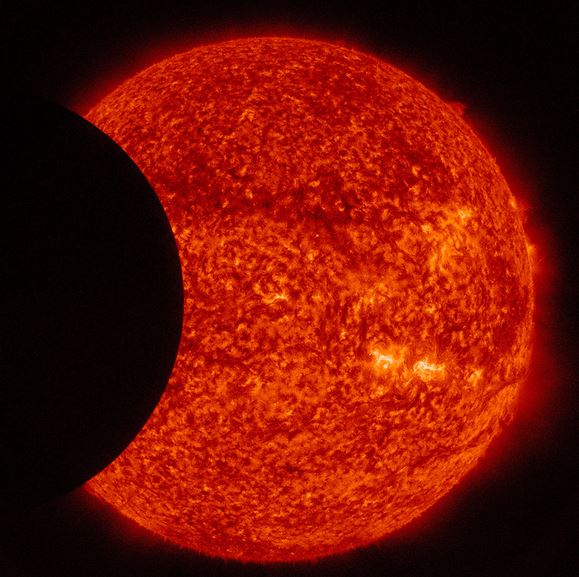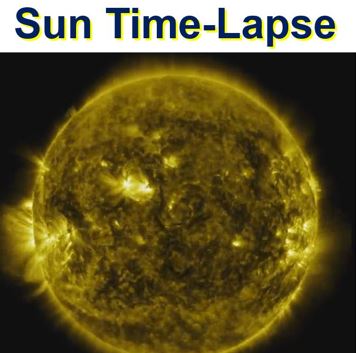A spectacular timelapse Sun activity video, which shows all movements over the course of one year, has been released by NASA. The Sun is forever moving and NASA’s Solar Dynamics Observatory (SDO), which was first launched on 11th February, 2010, has been watching it non-stop.
The video footage consists of millions of images – one taken every 12 seconds in ten different wavelengths.
These images are based on a wavelength of 171 angstroms – the extreme ultraviolet range that shows solar material at about 600,000 kelvins (c. 1,079,540°F). Within this wavelength, it is easy to see our Sun’s 25-day rotation.
 Many of us think the Sun just stays there motionless in the sky bringing us light and warmth. There is a lot going on, as you can see in the time-lapse video below. (Image: Solar Dynamic Observatory)
Many of us think the Sun just stays there motionless in the sky bringing us light and warmth. There is a lot going on, as you can see in the time-lapse video below. (Image: Solar Dynamic Observatory)
Sun’s apparent size changes
According to the Goddard Space Flight Center:
“During the course of the video, the sun subtly increases and decreases in apparent size. This is because the distance between the SDO spacecraft and the sun varies over time.”
“The image is, however, remarkably consistent and stable despite the fact that SDO orbits Earth at 6,876 mph, and Earth orbits the sun at 67,062 mph.”
The video shows the entire sixth year – from 1st January 2015 to 28th January 2016 – as one time-lapse sequence. It is ultra-high definition 3840 by 2160 and 29.97 frames per second. Each frame represents a period of 2 hours.
 According to NASA: “The sun is a star, a hot ball of glowing gases at the heart of our solar system. Its influence extends far beyond the orbits of distant Neptune and Pluto. Without the sun’s intense energy and heat, there would be no life on Earth. And though it is special to us, there are billions of stars like our sun scattered across the Milky Way galaxy.” (Image of the moon transiting across the sun)
According to NASA: “The sun is a star, a hot ball of glowing gases at the heart of our solar system. Its influence extends far beyond the orbits of distant Neptune and Pluto. Without the sun’s intense energy and heat, there would be no life on Earth. And though it is special to us, there are billions of stars like our sun scattered across the Milky Way galaxy.” (Image of the moon transiting across the sun)
Scientists study these images to gain a better understanding of the complex electromagnetic system that causes the constant movement of the Sun, which can affect what happens here on Earth.
Solar flares and another kind of solar explosion called coronal mass ejections have been known to disrupt communications technology.
NASA added:
“Moreover, studying our closest star is one way of learning about other stars in the galaxy. NASA’s Goddard Space Flight Center in Greenbelt, Maryland, built, operates and manages the SDO spacecraft for NASA’s Science Mission Directorate in Washington, D.C.”
Video – Sun activity over a 1-year period
As you can see in this NASA Goddard video, the sun is always changing.
Sun facts
4 Layers: most of the Sun’s interior is made up of the core, radiative zone and convection zone. The part that shines on the planets is called the photosphere.
Big Blasts: coronal mass ejections send billions of tons of particles into space – they can cause bright auroras on Earth and damage electronics.
Cool Hot-Spots: the Sun has temporary dark areas called sunspots, where concentrated magnetic fields restrict the transfer of energy from below, thus cooling down the surface.
It is Huge: the Sun’s volume is approximately a million times Earth’s. You could crush up a million Earths and they would fit inside it.
Most of Mass: most of our solar system’s mass – 99.8% – consists of the Sun, leaving just 0.2% for the planets and everything else.
Superhot: the Sun’s core temperature is about 15 million degrees Celsius or 27 million degrees Farenheit.
Middle-Aged: the Sun is about 4.6 billion years old. In a few billion years it will become a white dwarf.

